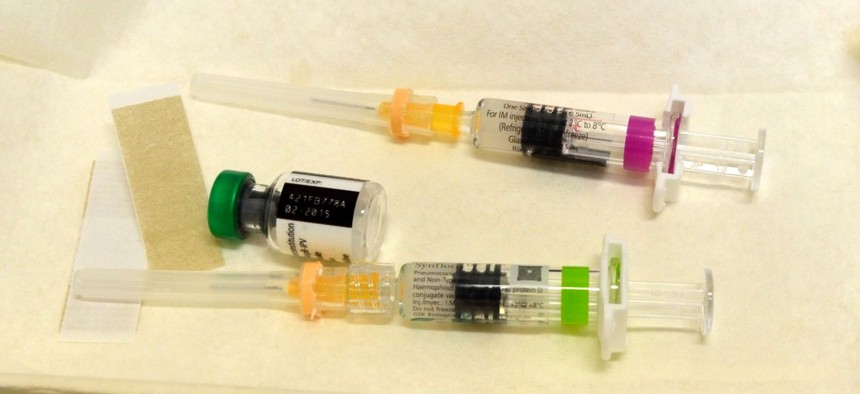GOP Health Care Plan Would Eliminate an Important Disease Prevention Fund

Shutterstock
State and local public health departments alone stand to lose as much as $3 billion over the next five years.
WASHINGTON — Amid discussions surrounding the new health care proposal introduced by U.S. House Republicans this week, a lot of attention has been paid to the future of Medicaid, the Planned Parenthood funding freeze, and the implications of eliminating the individual mandate. But there’s one subtler—and no less crucial—change that will impact the entire fabric of the American public health system that state and local governments shouldn’t overlook.
As part of their proposal, House Republicans intend to eliminate the Prevention and Public Health Fund, the largest individual federal funding source set aside for disease prevention, by 2019.
This isn’t the first time the fund—which was established by the Affordable Care Act in 2010—has come under attack from the GOP. In 2012, House Republicans proposed a plan that would maintain a low interest rate for Stafford student loans by cutting funds from the PPHF. And, earlier that same year Congress dipped into the fund to use $5 billion to pay for a payroll tax extension. In fact, since its creation, the PPHF’s original allocation has already been cut by 50 percent.
Setting aside the vast implications of the fact that the fund accounts for 12 percent of the U.S. Centers for Disease Control and Prevention’s entire budget, the loss of that money would be felt in communities across the country.
According to Chrissie Juliano, the director of the Big Cities Health Coalition, which is part of the National Association of County and City Health Officials, without an alternative funding source, state and local public health departments alone stand to lose as much as $3 billion over the next five years. And, an additional $2 billion could be lost to the entire public health system in that same time period.
That $5 billion supports health initiatives that touch lives all across the country—from immunization initiatives to breastfeeding promotion to diabetes prevention.
“There’s going to be less money to go around, and those at the local level often feel that the most,” Juliano told Route Fifty.
From Juliano’s perspective, one clear problem is that it appears “there are varying degrees of understanding on Capitol Hill on how important those dollars are.”
Here are a few of the programs that the Prevention and Public Health Fund supports:
- The Section 317 Vaccination Program makes up the largest chunk of PPHF allocations. In fiscal year 2016, the fund made more than $324 million available for the federal government to purchase vaccinations for children, adolescents and adults. Funding from the PPHF makes up half of the total budget for the immunization program. Given the fact that vaccination rates are already decreasing in certain states, cuts to this program are particularly concerning.
- The PPHF remains one of the major sources of funding for lead poisoning prevention. In fiscal year 2016, the PPHF allocated $17 million to this initiative that’s been show to be cost-effective. It’s been shown that every $1 spent on reducing lead poisoning hazards saves at least $17 in direct and indirect costs.
- Preventative Health and Health Services Block Grants, which accounted for $160 million of the PPHF in fiscal year 2016, are especially vital to local health departments. Much of the federal money that reaches the local levels comes tied to specific diseases or initiatives, while these block grants allow for more flexibility which in makes it possible for local officials to fund programs tailored to the needs of their communities.
These big-ticket items made possible by the PPHF are crucial, but Juliano also emphasizes that they aren’t the only purpose of the fund. “The intent of the fund was really to provide a mandatory funding stream for new and innovative prevention activities meant to get and keep people healthy, and prevent people from getting sicker,” she said.
And, Juliano said, without the funding, these local departments are going to have to do what they’ve always done, figuring out how to do more to keep their people healthy with less.
While she said “it’s really critical that those dollars be made up moving forward,” Juliano is not willing to “place a bet on where dollars are going and where dollars are coming from.”
One thing Juliano made sure to emphasize in conversation with Route Fifty is just “how integral the Prevention and Public Health Fund is to the infrastructure of our public health system.”
“Without supporting these on-the-ground efforts, these core public health efforts, we really do weaken our entire health system,” she says. “The ACA isn’t just about coverage but about all these other pieces that affect the health of our communities.”
Reflecting on the difference these basic public health initiatives funded by the PPHF make in people’s lives, Juliano is reminded of a saying that’s been kicked around, attributed to Karen DeSalvo, a former acting assistant secretary for health.
“Public health saved your life today and you didn’t even know it.”
Quinn Libson is a Staff Correspondent for Government Executive’s Route Fifty based in Washington, D.C.

NEXT STORY: States Would Likely See Big Drop in Medicaid Funding Under Obamacare Repeal Plan






